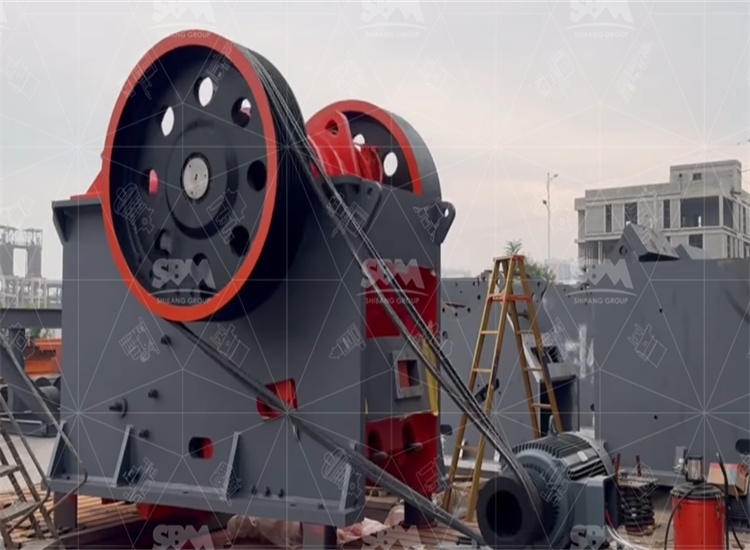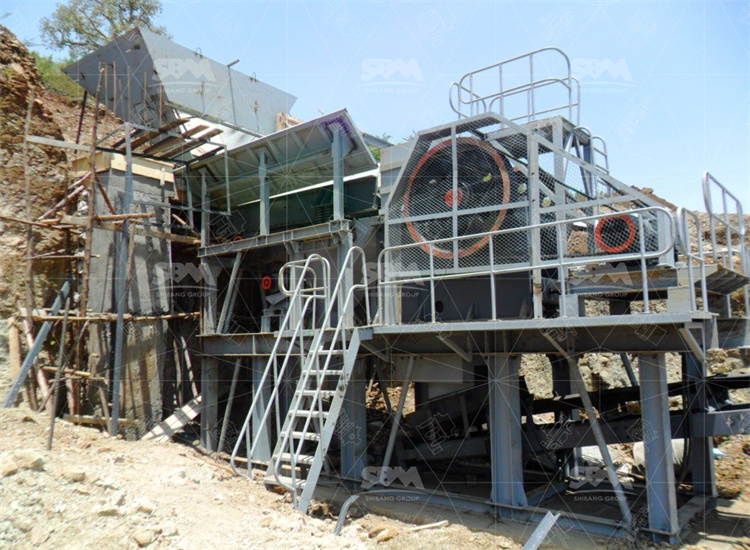A practical, field-proven guide to select a jaw crusher that fits your ore. It explains mechanics, key parameters, energy and maintenance data, and shows two real projects done by Shanghai SBM. Read fast, decide smarter.
A jaw crusher uses a moving jaw and a fixed jaw to compress and break rock. Material feeds into a V-shaped chamber, then is squeezed by the moving jaw. The crushed product discharges at the bottom gap. This design makes the machine ideal for coarse primary reduction. The simple kinematics give predictable product gradation and robust operation. Furthermore, jaw crushers usually work best when fed consistently, not in spikes.

To match a crusher to an ore, you must inspect several parameters. Specifically, crushing ratio, CSS/OSS, jaw chamber profile, stroke, eccentric speed, motor power and throughput. Each affects size reduction, energy use, and wear. Below we explain each, with practical ranges and how they interact.
The crushing ratio is feed size divided by product size. Typical jaw crushers show 6:1 to 8:1 reduction for primary crushing. Thus a 600 mm lump can be reduced to 75–100 mm in one stage, depending on CSS. Use higher ratio only when feed is fairly uniform, otherwise staged crushing is safer.
OSS is the largest gap measured when stationary. CSS equals OSS minus the average stroke. CSS controls max product size. Measure OSS when stopped, then compute CSS; follow manufacturer stroke tables for exact subtraction. Small CSS yields finer product but reduces throughput and raises wear.
Profile (aggressive vs smooth) determines bite and product shape. Aggressive profiles give fast breakage but higher fines. Smooth profiles make cubical product with lower capacity. Choose profile by downstream needs; e.g., if cone or mill follows, prefer coarser product to reduce energy there.
Stroke and eccentric speed set the throw and the number of crushing events per minute. Higher speed often raises throughput but can increase energy per tonne and wear. Optimizing speed can reduce kWh/t by 10–25%. Test at site for best balance.
Select motor so the crusher runs at or slightly below rated capacity under expected rock hardness. Undersized motors stall; oversized motors waste cost. Typical primary jaw motors range from 75 kW to >500 kW for high-capacity plants. Match gearbox, V-belt and starter to avoid electrical trips.
Throughput depends on feed size, CSS and chamber fill. For coarse ores, expect lower tph for the same crusher size than for softer rock. Use curve data from test work to predict tonnage at your CSS. In practice, measure feed distribution on site before final selection.

Operators demand real numbers. Below are practical ranges observed in industry trials and studies. Use them as decision anchors; then verify with plant trials.
| Parameter | Range (typical) | Notes |
|---|---|---|
| Crushing ratio | 6:1 – 8:1 | Primary coarse feed |
| Energy (crushing stage) | 0.5 – 1.3 kWh/t | depends on ore hardness, speed |
| Motor power | 75 – 500+ kW | plant scale dependent |
| Maintenance interval | weekly checks, major service 6–12 months | depends on duty |
| Average downtime (failure) | 1–5% of operating time | improvable by PM |
Energy for a crushing stage normally sits between 0.48 and 1.32 kWh per tonne for ores tested. Thus jaw crushing often consumes modest energy compared to grinding. Nevertheless, speed and feed control change that number sharply. Moreover, failure analyses show component wear and unexpected breakdowns are the dominant cost drivers; proper PM drops failure rates substantially.
Follow a clear process. First, characterize ore. Second, set product spec. Third, compute required reduction ratio and throughput. Fourth, select candidate crushers and size motors. Fifth, run pilot or lab crushing tests. Sixth, validate with a plant trial. Use this checklist as executable steps.
Measure feed size distribution, Mohs hardness (or Bond work index), moisture, and abrasivity. These four define most crusher risks. For sticky or high-clay ores, prefer larger stroke and aggressive wear liners.
Pick target top size and percent passing. Then compute required CSS and reduction steps. If you need 80% passing 150 mm from 600 mm feed, a single-stage jaw may be OK; otherwise plan secondary crushing.
Use manufacturer capacity curves, but reduce calculated tph by 10–15% for harder rock. Confirm motor sizing with a service factor for shock loads. Finally, include spare parts list and recommended maintenance schedule in the bid.

Install on rigid foundations, level the frame, check bearing preloads, and align drives. Commission with graduated feed ramps; monitor amperage and vibrations. For maintenance, schedule daily inspections, weekly liner checks and full gearbox inspection every 6 months. Keep a small stock of wear parts, toggle plates, jaw dies and a spare V-belt set. Preventive maintenance reduces unplanned downtime dramatically, and lowers life-cycle cost.
Background: open-pit, hard granite, feed 550 mm top size, target product 75 mm, target 150 tph. Conditions: variable feed, dusty climate, ambient 5–45°C.
Design choice: Shanghai SBM supplied a heavy-duty 42×30 jaw (model XH-J42) with 250 kW motor, aggressive chamber, stroke 30 mm and a CSS range 40–150 mm. We matched feed control with a variable-speed feeder and staged screening. The crushing ratio was set at 7:1. As a result, plant reached stable 140–160 tph after two weeks. Energy measured at 0.9 kWh/t during steady state, within expected band. Client note: installation took 10 days; commissioning was smooth; wear parts lasted 5 months under full duty. Customer praised our rapid spare delivery and clear maintenance plan.
Background: low hardness ore, moisture 6–12%, feed up to 300 mm, need 0–50 mm product, capacity 80 tph.
Design choice: SBM supplied XH-J28 with wider chamber and coarse tooth dies. We added a spray system and pre-separator to reduce clay ingress. CSS tuned to 30–45 mm to avoid pack-up. After six weeks, throughput averaged 85 tph and blocked-crush events dropped by 70%. Client feedback: simpler daily clean, fewer shutdowns, and lower liner wear than previously experienced.
Example A: feed 600 mm to 75 mm desired. Required reduction = 600/75 = 8:1. Choose machine rated for 150 tph at that reduction. Example B: target 80 tph, ore Bond index high; increase motor by 15% service factor to allow for shock loads and harder-than-expected rock.
A: If required product top-size is less than achievable CSS for single-stage and crushing ratio would exceed 8:1, add a secondary crusher. Also, if downstream mill power rises, secondary crushing that produces a coarser feed can cut grinding energy. Test on lab jaw first.
A: Keep liners and toggles in stock, calibrate CSS weekly, monitor bearing temperature and vibration, and enforce a feed ramp during start-up. These actions cut failures and extend intervals between major overhauls.
A: Field studies show proper speed and CSS tuning saves 10–25% energy per ton. Also, reducing over-crushing lowers grinding load later. So tune crushers, not just buy bigger machines.

Do not rely on price alone. Consider spare parts lead time, local service, and total life-cycle cost. A slightly higher capex for better drives and monitoring pays back in uptime. For ROI, track kWh/t, spare part spend, and downtime costs monthly. Use these to compare vendor offers.
In summary, choose a jaw crusher by matching feed characteristics, target product, and duty to machine geometry and drive. Validate with lab and site trials. Opt for correct motor matching, planned maintenance and a proven chamber profile. Shanghai SBM can provide pilot testing, full installation and local after-sales support to make the selection safe and predictable. For urgent advice, share your feed sieve curve, desired product spec, and duty hours; we will propose a short list, test plan, and expected kWh/t estimate.
Keep one set of jaw dies, one toggle, two bearing kits, and essential fasteners. Also store grease, a V-belt set and wear liner segments. This stock cuts downtime from days to hours.
With normal duty, expect minor service monthly and major gearbox or eccentric overhaul at 12–24 months. High-abrasion ores shorten interval; plan accordingly.
Yes. Send a representative sample for bench jaw testing. The test gives feed/product curves, energy per tonne proxy, and wear forecasts; it guides final machine sizing.
Whatsapp:+8617329420102
Email: [email protected]
Address: No. 1688, Gaoke East Road, Pudong new district, Shanghai, China.
Online Service : Get Price
We value your feedback! Please complete the form below so that we can tailor our services to your specific needs.
